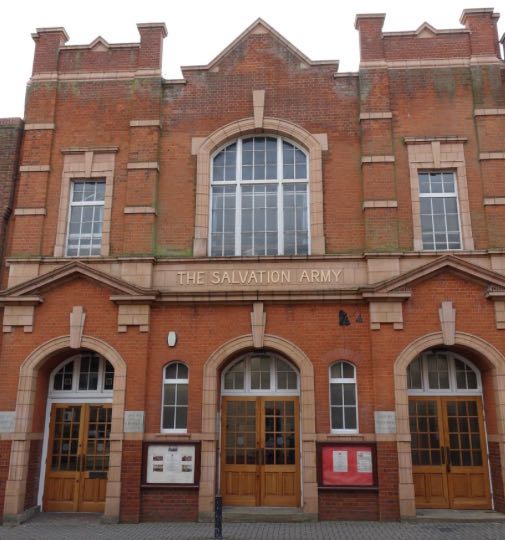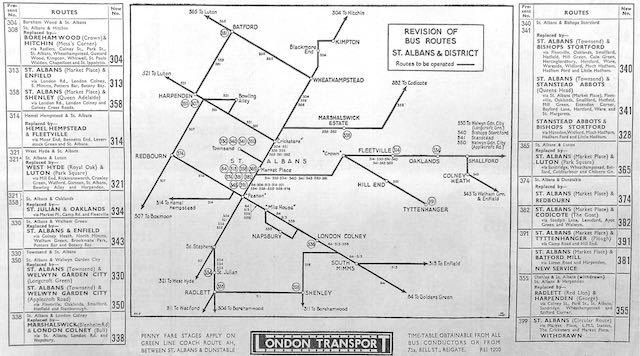The SAOEE website contains pages on most of the current primary and secondary schools in our East End. But there are and were other schools available to the children of the east side of the city – under the right circumstances. The wider history of schools in the city is a much more complex structure than the establishments which are open today, wherever the are, and for the most part is focused on the three parts of St Albans at the centre of the 1920s education re-organisation: West, Central and East. The latter was heavily delayed, however, and wasn't completed until 1932. We will review this re-organisation in later posts.
What might be more interesting initially is to explore a number of privately run establishments. Most of these were to be found in the central and inner wards; only two were known to have operated in the East End, specifically Beaumont Avenue and Elm Drive. I would urge readers not to expect much detail in what follows – I have relied heavily on display advertisements in the Herts Advertiser, and although parents throughout the city could have taken advantage of any of the establishments, their ability to do so was determined largely by their private incomes. What follows is arranged in no particular order and does not express a complete statement of what is known about each school.
 |
An infants classroom at Oxford House school.
COURTESY ANDY LAWRENCE
|
Oxford House Schools was in existence before 1880; a boys' establishment under the tutorship of Mr G James Nettleton in Alma Road. Later moving to possibly larger premises, it found accommodation in Bricket Road. After this move it offered an education to girls in separate accommodation, and to day pupils as well as boarders.Rochester House School, quickly retitling it to Rochester House High School, was owned by Miss Clara Bamforth. First noted in London Road in the 1890s it later moved to 101 St Peter's Street, next to The White House. Miss Bamforth specialised in elocution training.
Gentlemen's Preparatory School was in one of the Hatfield Road villas in St Peter's Park. In 1900 it is associated with Mr J Harrington, but by 1919 it was advertised for "young gentlemen from 5 to 13" and in the charge of Mr W Millington at Wellington House, Bricket Road.
Rowlatts. First spotted in advertisements in 1886 when Miss Lewin announced it as The High School for Girls in London Road, but within the year Miss Lewin had purchased a villa named Rowlatts in The Avenue. The advertisements are linked to a separate school named Lyndale on the corner of Hillside and St Peter's roads. Lyndale was kept by the three Sheehan sisters but was then a school for boys.
 |
A day visit made by children of Lyndale School
COURTESY DIANA DEVEREUX
|
Manor Lodge was in Upper Lattimore Road and run by Miss Palmer, who gave a Ramsgate address, and Miss Miskin, who offered a Paris address! It began as "a high class school for girls" (1886); by 1907 it was able to add "with classes for little boys."Loreto College began in a private house – a large one – in Hatfield Road where they are still located. This successful school was soon able to expand (in the 1920s) by taking over a garden nursery, and the house and land of Marlborough House which had belonged to Samuel Ryder, before his family moved to Clarence Road.
Merrilands. A later arrival on the private scene, it was opened in 1933 in a bungalow by Miss I M Kell in Elm Drive. The pupils wore orange and grey uniforms. The school had closed by 1960.
 |
The impressive buildings and grounds of Birklands in London Road on a pictorial postcard.
|
 |
Few private schools were identified by name on maps. The expansive Birklands College for Girls is shown on the OS 1924 map. The main road shown on the right is London Road before the lower
end was diverted to leave this section as a cut-de-sac in the 1960s.
COURTESY NATIONAL LIBRARY OF SCOTLAND
|
Birklands. Probably grew to be the finest school building and site, Birklands moved into a substantial house built for wealthy Henry Jenkin Gotto in 1883, partly on land acquired from Newhouse Park. The property was sold to Miss Elizabeth Cox, who moved her small girls' school there from Highgate. Although moving out during 1939 the school re-opened in 1945. Part of the site was sold for housing as Whitecroft, and later Hertfordshire County Council purchased the main property for Hatfield Polytechnic, later becoming the University. It is now a range of apartments.Clare House began life in Stanhope Road in the 1890s, but by WW1 it had moved to Lemsford Road. It was still listed in Kelly's 1932 directory as a girls' school. The boys' prep class which was part of the original school was not, it appears, included in the move.
Claremont House had began life under the name College House in College Street, then moved to Alma Road. Advertisements had been appearing in the Herts Advertiser since 1872 under the rather long name of Mr C Root's Middle Class Boarding and Day School for Young Gentlemen. In this year Claremont House was described as The Classical Commercial and Scientific School intended for day boys and boarders. Mr Wroot was still the owner in 1898, by which time the 13-bedroomed building was taken over by Mr J. Harrington.
Russell House. The final advertisement for this school appeared in 1932 Kelly's Directory. Opened c1914 in premises formerly occupied by the High School for Girls at the former cottage hospital in Holywell Hill. Russell House was owned and run by three sisters, the Misses Cloute.
Aylesford House. This boys' school was begun by Mr W Hanford Turner from a villa on the country side of the London Road railway bridge. Ownership later passed to Mr C Leighton. A second villa was later purchased next door, and in the 1930s ownership was transferred to Mr and Mrs Bayley, who announced that it was their intention to "take boys from 7 to 14 for acceptance to public schools and the Royal Navy." The uniform was grey with pink edging. The school moved to part of Sandridgebury House in 1947, and from 1958 it was jointly run by Mr J Thompson and Mr R H Lee.
The Hall. For a short time around 1930 a small school "for young children" under this name was opened at 20 London Road, supervised by Miss Elsie Bodkin. This was the address of the former Temperance Hotel.
Verulam School. Not the establishment in Brampton Road, but one of the villas overlooking Clarence Park at 88 Hatfield Road. Owned by Mr J W Cassels it espoused "a modern and practical education". It was first spotted in 1903, and by 1919 had moved to Upper Lattimore Road. While beginning as a boys' school the move appeared to coincide with a change of ownership to a Miss Collier, where the emphasis shifted to a girls' school with a boys' prep class attached.
Dirleston House School. It opened its doors c1901 in a quite new house at the Sandpit Lane end of Battlefield Road, owned by Mr John Henderson. It is thought the school had closed by 1911.
Athalls. Housed in what was probably new accommodation in Hall Place Gardens in 1907; pre-empting the arrival of the High School for Girls by some two years. "A boarding and day school for young ladies." It is directory listed after the junction with Townsend Drive; if correct then Maple School occupies this site today. Mrs Brumleu was in charge and lived in the house next door.
Grosvenor House. A girls' boarding and day school "with classes for little boys", run by the Misses Garlick from a house in Bricket Road. It advertised a "resident French mistress and fully qualified visiting staff." The school was c1908 vintage but the length of its tenure is unknown.
Home School for Girls: Probably opened c1898 "for yearly, weekly and daily boarders". Owned by Mr and Mrs Baird at Worley House.
Windcliffe advertised in 1898 as "a school for the daughters of gentlemen." Owned by Miss Elizabeth Sheehan from a house in Hatfield Road.
St Albans Kindergarten and Preparatory School. Open around 1930 from 26 Beaconsfield Road, and owned by Miss Kathleen Kidd.
Holywell House School from a house formerly owned by Mr and Mrs Wix. In 1931 it was purchased by the Misses Cloute who converted the house into a school – for boarding and day girls, and a boys' prep class. Even evening classes were advertised. The school closed c1960 when it became commercial premises for S Lander, architects.
Durnford House opened in 1951 in part of the Liberal Club building at 9 Hatfield Road. The principal was Mrs Ruby E Holby. Its uniform colours were wine and blue, with the initials DH in the centre of the blazer badge. There was space for 10 day pupils from 6 years upwards; by 1953 it had moved to occupy The White House in St Peter's Street north while retaining the Liberal Club and a house at 19 Hall Place Gardens. Pupil numbers quickly increased to 150 three to 18 year olds. However, the establishment was thought to be effectively bankrupt and was looking to consolidate its use of accommodation. Last referenced in 1955 but may have lasted longer.
The Misses Wright School for Young Ladies, Shanklin House, 38 Victoria Street, opened in 1877 and appeared to have a short life.
Battlefield House School. Miss Mason opened the school at 4 Chequer Street, and was advertising between 1880 and 1886.
Mr Hawkes' High Grade Elementary School advertised at 13 Verulam Road in 1886. "Mr Hawkes will be preparing boys for Oxford and Cambridge entrance examinations, and the College of Preceptors and Post Office exams. Mrs Hawkes looks after the under sevens."
Miss Hestor's School advertised in 1887 at 3 Victoria Street and was probably one of the shortest lived establishments.
The Ladies' School advertised in 1872 stating that it was located at Alban House, under the care of Miss Upton. It is not known where Alban House was located.
Alma Road Girls' School. This may have been an early iteration of Clare House School in Alma Road. An advert appeared in a low circulation newspaper called The Clocktower in which the Head was named as Mrs Deed.
 |
St John's Lodge, formerly Avenue House, in Beaumont Avenue, part of which was occupied by
St John's School.
COURTESY HALS
|
St John's Prep School, accommodated in part of St John's Lodge, Beaumont Avenue (now the site of St John's Court) by the Misses Blackwood in the 1920s. How successful this school was is not certain, but when the Blackwoods moved c1936, the school transferred to a house on the north side of Jennings Road.Well, that's a substantial list of educational establishments! Within that total may have existed the occasional school which was essentially one place of learning, but with a changed name, especially if it was taken on by a new owner. Many owners possessed brave ideas which failed to live up to promise; others carved out small reputations for themselves with names that have lived on in our local history. And it is probable readers got to know one or two of them, or they or their relatives may have attended as pupils. I am not claiming either that the above is a complete list. So contributions from readers will be welcomed.
































